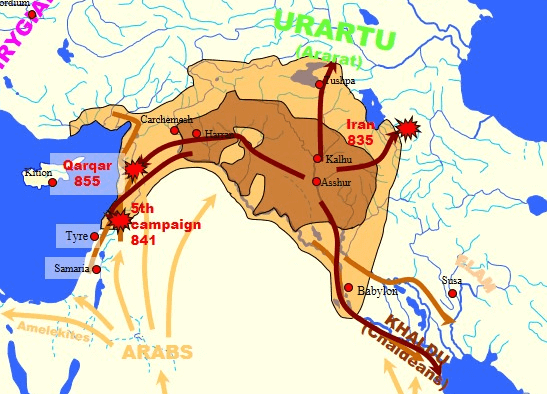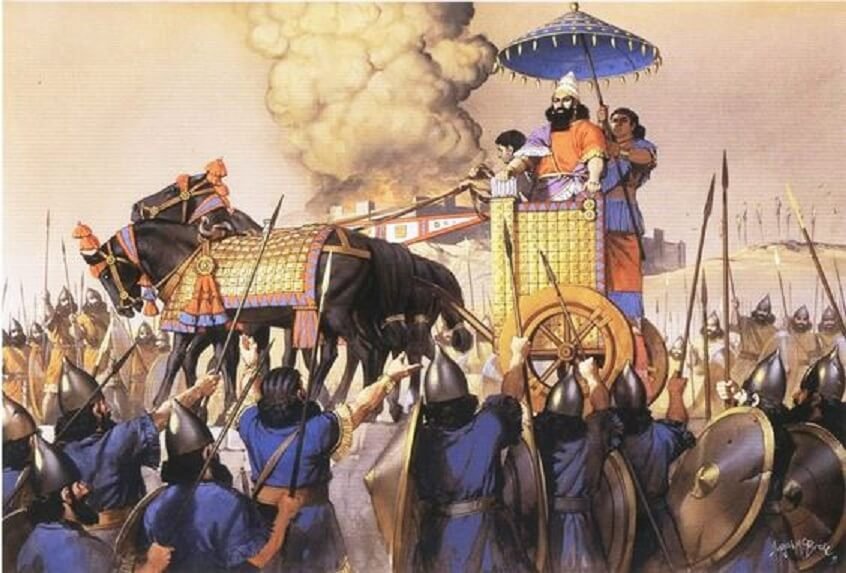The Battle of Qarqar, fought in 853 BCE, stands as a landmark event in the annals of military history, notable for featuring the earliest documented military alliance among a coalition of twelve kingdoms. This confederation was assembled to counter the expansive ambitions of the Assyrian Empire under King Shalmaneser III. The battle, although not decisively conclusive in its military outcomes, offers profound insights into the geopolitical dynamics of the ancient Near East and the complexities of coalition warfare.
Background and Strategic Context
During the early 9th century BCE, the Assyrian Empire, led by Shalmaneser III, was in a phase of aggressive territorial expansion. Assyria's military campaigns were directed towards consolidating control over trade routes and subjugating regions rich in resources. This expansionist policy inevitably brought Assyria into conflict with the states of the Levant, which were determined to resist Assyrian domination.
The strategic significance of Qarqar, located on the Orontes River in modern-day Syria, derives from its position as a crucial junction controlling access to the Mediterranean coast. The battle that unfolded there was precipitated by Assyria’s move to secure control over this pivotal region, prompting the formation of an unprecedented alliance among the kingdoms of the Levant.
The Grand Alliance
The coalition, famously chronicled in the Kurkh Monolith—a stela inscribed with the annals of Shalmaneser III—comprised an array of twelve kings. This alliance included Hadadezer of Damascus, Ahab of Israel, Irhuleni of Hamath, and other rulers from the Aramean and Syrian states, as well as contingents from Egypt and possibly the remnants of the Hittite empire. The text claims that the combined forces amounted to a formidable count of more than 50,000 infantry and 4,000 chariots, a figure likely exaggerated by Assyrian scribes to glorify their military prowess.
This alliance is considered the first of its kind due to its scale and the diversity of the participating polities. It exemplifies a sophisticated level of diplomatic negotiation and military coordination among ancient states, each with its own interests and motivations for joining the coalition against a common adversary.
Illustration of the Battle of Qarqar in 853 BCE between the Neo-Assyrian Empire led by Shalmaneser III and an alliance of twelve kings who waged war against him. Illustration by by Seán Ó’Brógáín.
The Battle and Its Aftermath
The battle itself was a massive engagement, with both sides deploying large forces in a confrontation that lasted the entire day. Assyrian records claim a victory, boasting of immense slaughter and a tactical retreat by the enemy. However, the lack of decisive Assyrian follow-up actions and their temporary halt of further advances into Levantine territories suggest a more ambiguous outcome. It appears that the coalition managed to check Assyria’s advance, preserving their autonomy for a time, despite not achieving a clear-cut battlefield victory.
The immediate aftermath of the Battle of Qarqar saw a temporary stabilization of borders but no lasting peace. Subsequent campaigns by Shalmaneser III over the following years indicate that the Assyrian threat persisted, leading to further conflicts in the region. Nevertheless, the alliance at Qarqar set a significant precedent for collective defense against imperial conquest, highlighting the potential of coordinated multi-state resistance.
Historical Significance and Legacy
The Battle of Qarqar is a seminal example of ancient diplomacy and warfare. It illustrates the complexities of alliance warfare, where diverse political entities with varying capabilities and goals come together to confront a superior power. The battle underscores the importance of strategic geography and highlights the perennial struggle for control over vital trade routes and economic resources in the ancient world.
Moreover, the Qarqar alliance provides early evidence of the lengths to which communities will go to preserve their independence and identity in the face of overwhelming odds. This event not only offers a glimpse into the military tactics of the time but also into the diplomatic negotiations and alliances that have come to define much of human history.
In conclusion, the Battle of Qarqar and the alliance formed to contest Assyrian dominance mark a significant chapter in military history, embodying the earliest known instance of a large-scale coalition formed in response to the threats posed by imperial ambitions. This episode serves as a testament to the resilience and resourcefulness of the ancient states of the Near East, whose legacy of cooperation and conflict continues to inform our understanding of international relations and military strategy today.










